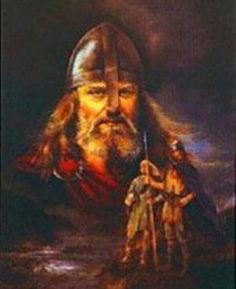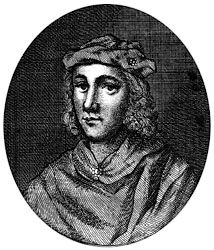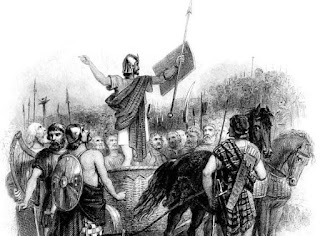Declaration of Arbroath
Who was where, as the seals were set?
Who were the 40 people who put their seals to the Declaration of Arbroath to convince Pope John XXII that Robert Bruce was their rightful king?
Some were Bruce supporters who had benefited from their loyalty to his cause in lands and titles. Nobles like Thomas Randolph, earl of Moray; Walter Stewart, the Steward of Scotland; Robert Keith, marischal of Scotland; James, lord of Douglas, the famous 'Good Sir James'; and Gilbert Hay, of Errol in Perthshire.
Gaeldom, too, lent its support. Bruce in his hour of darkness had fled to the Celtic west where the MacDonalds sheltered him - and it is interesting to note, in the light of later history, that the Campbells were Bruce's kin.
Donald Campbell is listed, and his brother Neil, who had fought for Bruce since 1306, had married the king's sister, Mary.
Others were more reluctant converts to Bruce—particularly those on the front line between Scotland and England in East Lothian where diplomatic skill counted more than patriotism.
Alexander Seton, of Seton in East Lothian, had been captured after the battle of Methven and remained in English allegiance until the eve of Bannockburn—when he deserted and brought Bruce news of low English morale. Bruce rewarded him with lands around Tranent.
Patrick Dunbar, Earl of March, a descendant of the Angle kings of Northumbria, frequently changed allegiance. His lands around Dunbar in East Lothian were plundered by Bruce and the English. Yet in 1314 Bruce confirmed his earldom, bringing him into allegiance. It was one of Patrick's knights, Sir Adam Gordon, who took the Declaration to Pope John XXII at Avignon, in France.
Some Scots could never sign the Declaration. They were the disinherited, the Balliols, and their Comyn supporters. But some were forcibly brought into the Bruce fold and joined the Declaration that justified Bruce's usurpation.
William Leslie, Earl of Ross, had been a Balliol guardian north of the Spey, but was brought to Bruce's side after Ross was invaded in 1307.
William Oliphant was possibly the son of the keeper of Perth who held the town against Bruce. He, too, was granted lands by Bruce.
Some converts became active supporters. Duncan MacDuff, Earl of Fife, changed sides in 1314. Along with William Sinclair, Bishop of Dunkeld, he repelled an English invasion of Fife in 1317. The bishop's elder brother, Henry Sinclair of Roslin, assented to the Declaration and his son died taking Bruce's heart to the Holy Land.
The father and mother of Malise, Earl of Strathearn, were staunchly anti-Bruce. When Bruce threatened the father with death, he is reputed to have said his oath to Edward "isn't fragile like a glass". He lost his earldom but Malise backed Bruce, Malise's mother Agnes, Countess of Strathearn, was a daughter of Alexander Comyn of Badenoch. Deprived with her husband in 1313, she couldn't be reconciled to Robert I. Indeed, she—along with five other Balliol supporters of the Declaration—participated in the Soules plot to murder Robert Bruce.
The plot's name comes from one of its chief conspirators, William Soules, butler of Scotland, son of a former guardian of Scotland and a Comyn mother. Soules had strong pro-Balliol connections, as did all the plotters, and they probably aimed. to restore the Balliols to power. It's secrecy was compromised, however, and retribution was swift. William, along with Agnes of Strathearn, were sentenced to 'perpetual imprisonment' in Dumbarton Castle.
The betrayer was Murdoch Menteith, a relative of Sir John Menteith-the infamous 'false Menteith' who had betrayed Wallace and nonetheless put his seal to the Arbroath Declaration. For Murdoch's second Menteith betrayal, Bruce gave him an earldom.
Other names on the Declaration had differing levels of involvement.
Ingram Umfraville had opposed Bruce since Comyn's murder, even fighting for the English at Bannockburn. He knew of the conspiracy, but it was not for him, as he went into exile in France.
Patrick Graham of Invernesshire and Eustace Maxwell of the Borders were suspected but found innocent.
David Wemyss was possibly imprisoned for his part, and Roger Mowbray may have been the dead body at the trial.
David, Lord of Brechin, seems to have been most implicated in the plot. He had ever-shifting allegiances. Despite being captured by Bruce at Brechin in 1308, he was holding Berwick for Edward II a few years later—until he was captured by Bruce again when he sailed to Dundee.
By 1320 Brechin was once again in Bruce's court... deciding that the king's murder was an acceptable solution.
Brechin can be seen as an unreliable character who easily traded his allegiances, but he was relatively steadfast in his opposition to Bruce except when in his custody. Perhaps, though, Brechin had had enough and the assassination of Bruce, from his point of view, would have solved everything. We will never know.
Found guilty, Brechin was executed in a way designed to humiliate traitors—drawn through the streets and beheaded.
Whatever their political outlook, most Scottish nobles found the text of the Declaration something to which they could give their assent. Even if their deeds fell below its honourable sentiments.










Comments
Post a Comment